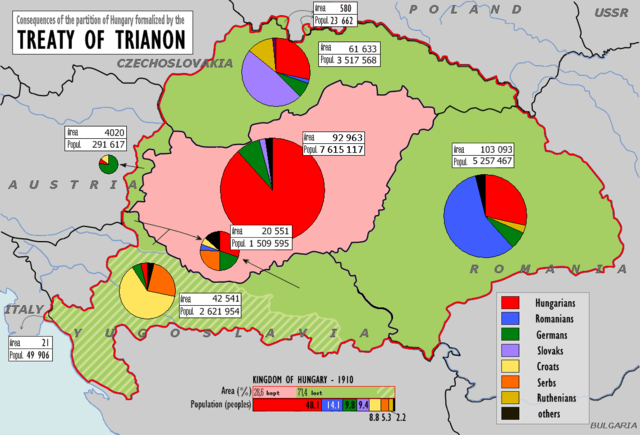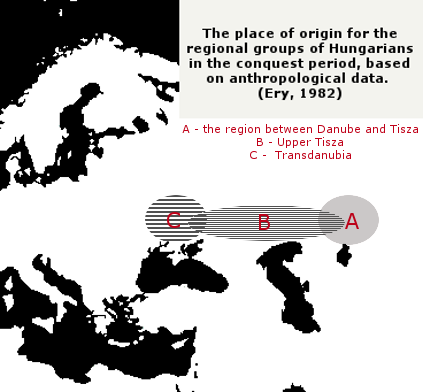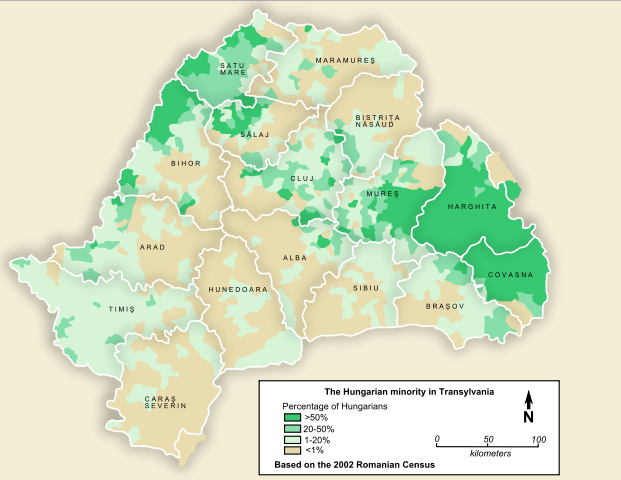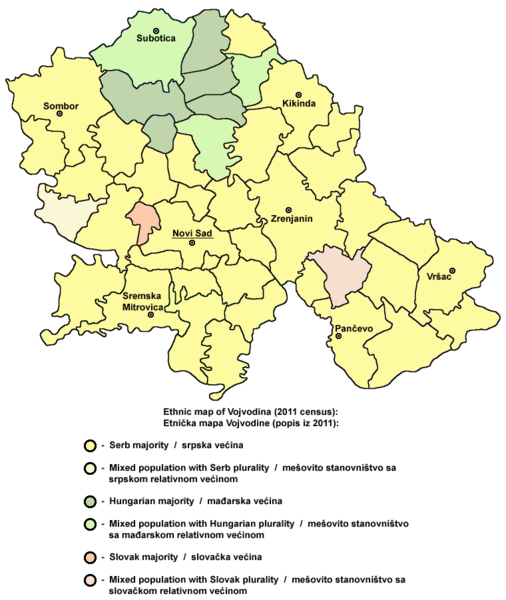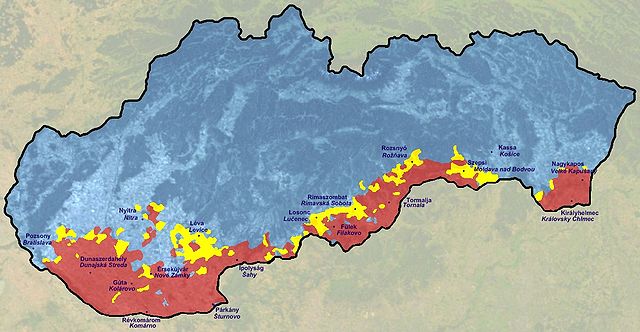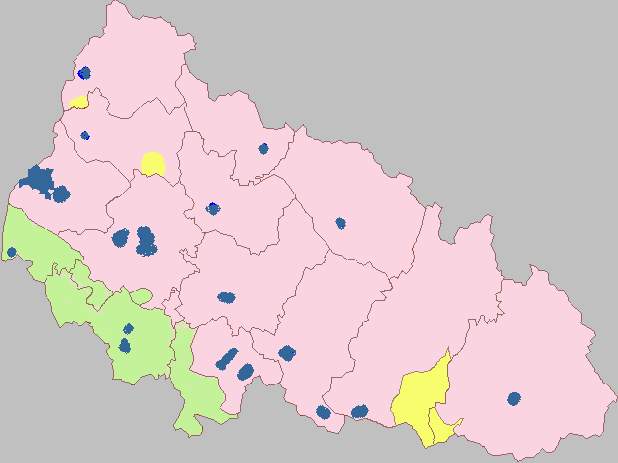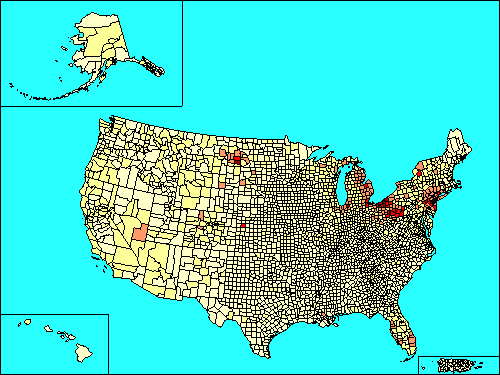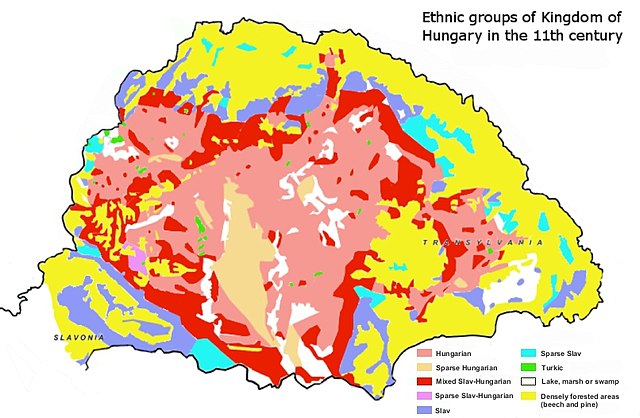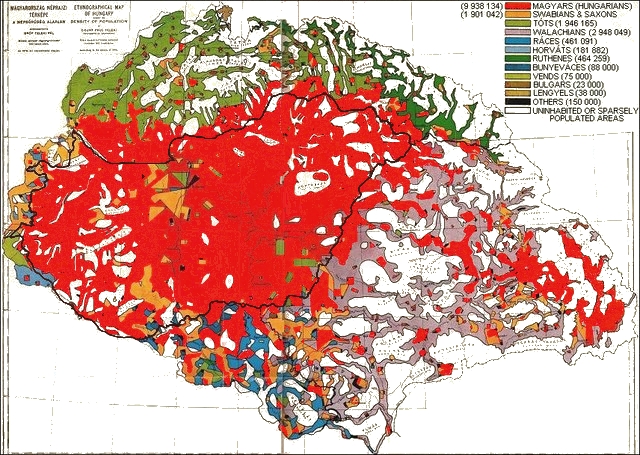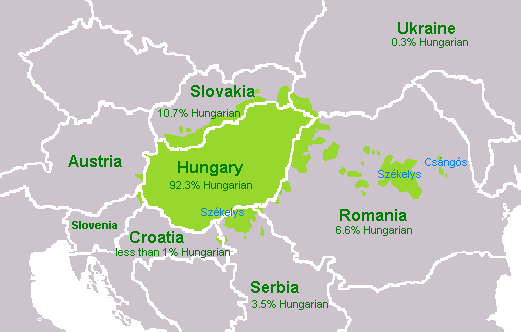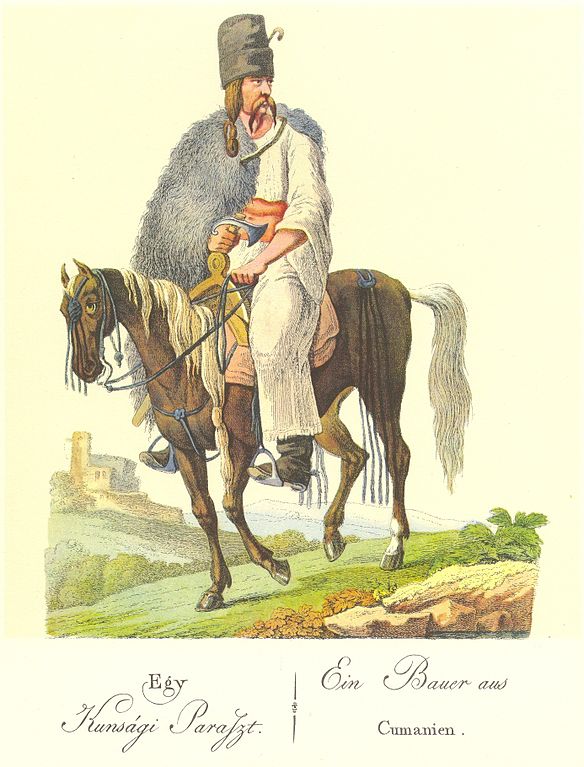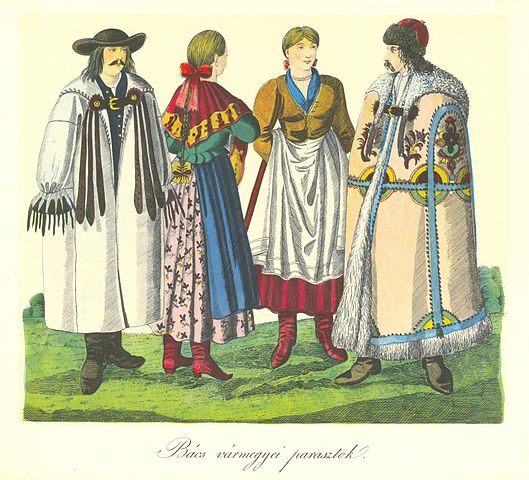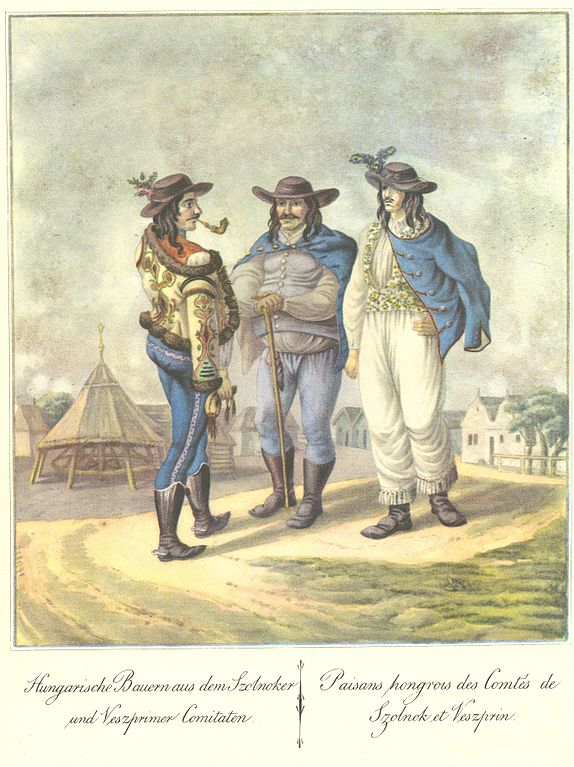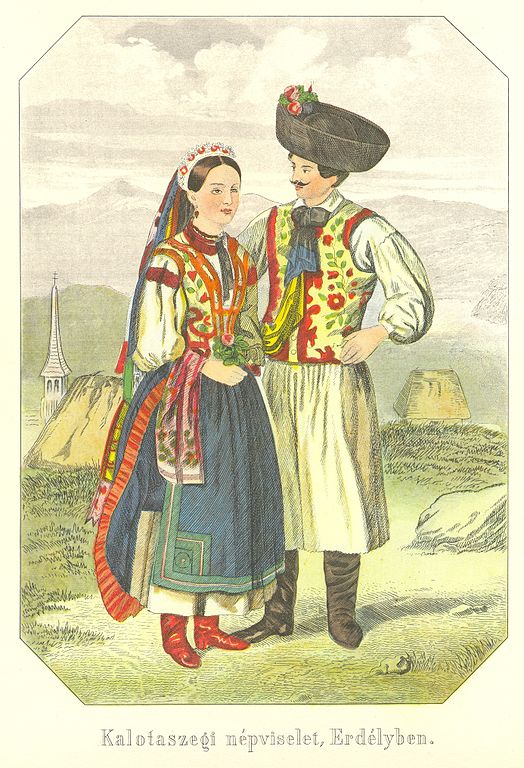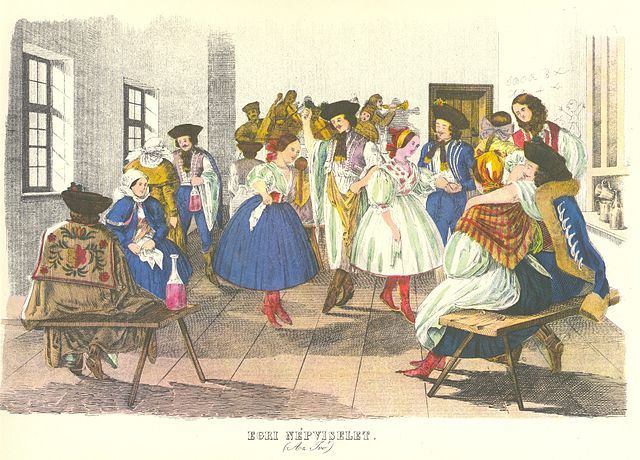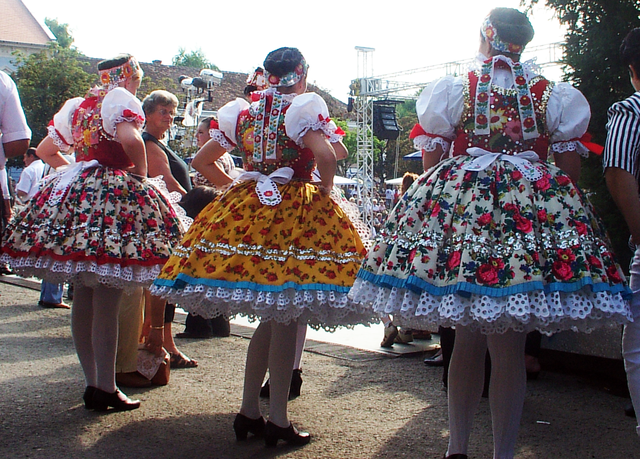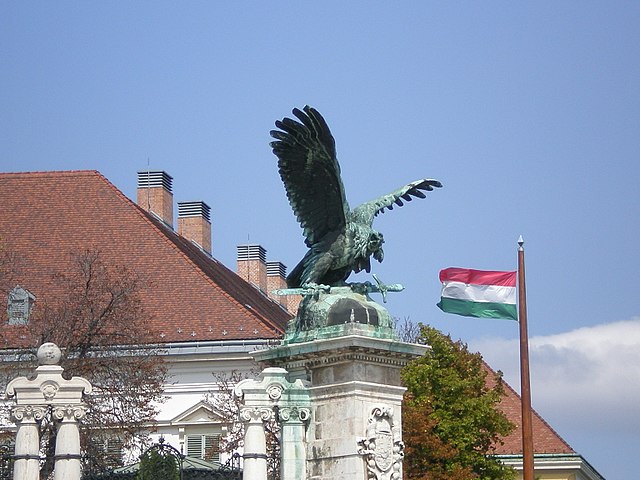
| HUNGARIANS
The seven Magyar chieftains arriving at the Carpathian Basin. Detail from Árpád Feszty's cyclorama titled the Arrival of the Hungarians Hungarians, also known as Magyars (Hungarian: magyarok), are a nation and ethnic group native to Hungary (Hungarian: Magyarország) and historical Hungarian lands who share a common ancestry, culture, history and language. Hungarian belongs to the Uralic language family. There are an estimated 14.2–14.5 million ethnic Hungarians and their descendants worldwide, of whom 9.6 million live in today's Hungary (as of 2016). About 2.2 million Hungarians live in areas that were part of the Kingdom of Hungary before the Treaty of Trianon in 1920 and are now parts of Hungary's seven neighbouring countries, Slovakia, Ukraine, Romania, Serbia, Croatia, Slovenia and Austria. Significant groups of people with Hungarian ancestry live in various other parts of the world, most of them in the United States, Canada, Germany, France, the United Kingdom, Brazil, Australia, and Argentina.
Hungarians can be divided into several subgroups according to local linguistic and cultural characteristics; subgroups with distinct identities include the Székelys, the Csángós, the Palóc and the Matyó. The Jász people are considered to be an originally Iranic ethnic group more closely related to the Ossetians than to other Hungarians.
Name
:
Prior to the Hungarian conquest of the Carpathian Basin in 895/6 and while they lived on the steppes of Eastern Europe east of the Carpathian Mountains, written sources called the Magyars "Hungarians", specifically: "Ungri" by Georgius Monachus in 837, "Ungri" by Annales Bertiniani in 862, and "Ungari" by the Annales ex Annalibus Iuvavensibus in 881. The Magyars/Hungarians probably belonged to the Onogur tribal alliance, and it is possible that they became its ethnic majority. In the Early Middle Ages, the Hungarians had many names, including "Wegrzy" (Polish), "Ungherese" (Italian), "Ungar" (German), and "Hungarus". The "H-" prefix is a later addition of Medieval Latin.
The Hungarian people refer to themselves by the demonym "Magyar" rather than "Hungarian". "Magyar" is Finno-Ugric from the Old Hungarian "mogyër". "Magyar" possibly derived from the name of the most prominent Hungarian tribe, the "Megyer". The tribal name "Megyer" became "Magyar" in reference to the Hungarian people as a whole. "Magyar" may also derive from the Hunnic "Muageris" or "Mugel". According to the Hungarian origin myth Hunor and Magor (first appeared in the 13th century chronicle Gesta Hunnorum et Hungarorum) the name "Magyar" was given after the legendary forefather, Magor. However, Hungarian historian and linguist András Róna-Tas argued for the reverse: namely, that the personal name Magor derived from the ethnonym Magyar, just as Hunor from Hun; and that Hunor and Magor are merely invented legendary heroes and never historically existed.
The Greek cognate of "Tourkia" was used by the scholar and Byzantine Emperor Constantine VII "Porphyrogenitus" in his De Administrando Imperio of c. AD 950, though in his use, "Turks" always referred to Magyars. This was a misnomer, as while the Magyars had adopted some Turkic cultural traits, they are not a Turkic people.
The obscure name kerel or keral, found in the 13th-century work the Secret History of the Mongols, possibly referred to Hungarians and derived from the Hungarian title király 'king'.
The historical Latin phrase "Natio Hungarica" ("Hungarian nation") had a wider and political meaning because it once referred to all nobles of the Kingdom of Hungary, regardless of their ethnicity or mother tongue.
History
:
However, the current consensus among linguists is that the Hungarian language is a member of the Uralic family and that it diverged from its Ugric relatives in the first half of the 1st millennium BC, in western Siberia, east of the southern Urals.
"Hungarian pre-history", i.e. the history of the "ancient Hungarians" before their arrival in the Carpathian basin at the end of the 9th century, is thus a "tenuous construct", based on linguistics, analogies in folklore, archaeology and subsequent written evidence. In the 21st century, historians have argued that "Hungarians" did not exist as a discrete ethnic group or people for centuries before their settlement in the Carpathian basin. Instead, the formation of the people with its distinct identity was a process. According to this view, Hungarians as a people emerged by the 9th century, subsequently incorporating other, ethnically and linguistically divergent, peoples.
Pre-4th century AD :
Map of the presumptive Hungarian prehistory During the 4th millennium BC, the Uralic-speaking peoples who were living in the central and southern regions of the Urals split up. Some dispersed towards the west and northwest and came into contact with Iranian speakers who were spreading northwards. From at least 2000 BC onwards, the Ugric-speakers became distinguished from the rest of the Uralic community, of which the ancestors of the Magyars, being located farther south, were the most numerous. Judging by evidence from burial mounds and settlement sites, they interacted with the Indo-Iranian Andronovo culture.
4th
century to c. 830 :
The Hungarians around the Don River were subordinates of the Khazar khaganate. Their neighbours were the archaeological Saltov culture, i.e. Bulgars (Proto-Bulgarians, Onogurs) and the Alans, from whom they learned gardening, elements of cattle breeding and of agriculture. Tradition holds that the Hungarians were organized in a confederacy of seven tribes. The names of the seven tribes were: Jeno, Kér, Keszi, Kürt-Gyarmat, Megyer, Nyék, and Tarján.
c.
830 to c. 895 :
Entering the Carpathian Basin (c. 895) :
In 895/896, under the leadership of Árpád, some Hungarians crossed the Carpathians and entered the Carpathian Basin. The tribe called Magyar was the leading tribe of the Hungarian alliance that conquered the centre of the basin. At the same time (c. 895), due to their involvement in the 894–896 Bulgaro-Byzantine war, Hungarians in Etelköz were attacked by Bulgaria and then by their old enemies the Pechenegs. The Bulgarians won the decisive battle of Southern Buh. It is uncertain whether or not those conflicts were the cause of the Hungarian departure from Etelköz.
From the upper Tisza region of the Carpathian Basin, the Hungarians intensified their looting raids across continental Europe. In 900, they moved from the upper Tisza river to Transdanubia (Pannonia), [citation needed] which later became the core of the arising Hungarian state. At the time of the Hungarian migration, the land was inhabited only by a sparse population of Slavs, numbering about 200,000, who were either assimilated or enslaved by the Hungarians.
Archaeological findings (e.g. in the Polish city of Przemysl) suggest that many Hungarians remained to the north of the Carpathians after 895/896. There is also a consistent Hungarian population in Transylvania, the Székelys, who comprise 40% of the Hungarians in Romania. The Székely people's origin, and in particular the time of their settlement in Transylvania, is a matter of historical controversy.
After 900 :
In 907, the Hungarians destroyed a Bavarian army in the Battle of Pressburg and laid the territories of present-day Germany, France, and Italy open to Hungarian raids, which were fast and devastating. The Hungarians defeated the Imperial Army of Louis the Child, son of Arnulf of Carinthia and last legitimate descendant of the German branch of the house of Charlemagne, near Augsburg in 910. From 917 to 925, Hungarians raided through Basle, Alsace, Burgundy, Saxony, and Provence. Hungarian expansion was checked at the Battle of Lechfeld in 955, ending their raids against Western Europe, but raids on the Balkan Peninsula continued until 970.
The Pope approved Hungarian settlement in the area when their leaders converted to Christianity, and Stephen I (Szent István, or Saint Stephen) was crowned King of Hungary in 1001. The century between the arrival of the Hungarians from the eastern European plains and the consolidation of the Kingdom of Hungary in 1001 was dominated by pillaging campaigns across Europe, from Dania (Denmark) to the Iberian Peninsula (contemporary Spain and Portugal). After the acceptance of the nation into Christian Europe under Stephen I, Hungary served as a bulwark against further invasions from the east and south, especially by the Turks.
Population growth of Hungarians (900–1980) At this time, the Hungarian nation numbered around 400,000 people.
Early
modern period :
Traditional Hungarian costumes, 1822 Other historians, particularly Slovaks and Romanians, argue that the drastic change in the ethnic structure hypothesized by Hungarian historians in fact did not occur. They argue that the Hungarians accounted for only about 30–40% [citation needed] of the Kingdom's population from its establishment. In particular, there is a fierce debate among Hungarians and Romanian historians about the ethnic composition of Transylvania through these times.
19th century to present :
In the 19th century, the proportion of Hungarians in the Kingdom of Hungary rose gradually, reaching over 50% by 1900 due to higher natural growth and Magyarization. Between 1787 and 1910 the number of ethnic Hungarians rose from 2.3 million to 10.2 million, accompanied by the resettlement of the Great Hungarian Plain and Délvidék by mainly Roman Catholic Hungarian settlers from the northern and western counties of the Kingdom of Hungary.
Spontaneous assimilation was an important factor, especially among the German and Jewish minorities and the citizens of the bigger towns. On the other hand, about 1.5 million people (about two-thirds non-Hungarian) left the Kingdom of Hungary between 1890–1910 to escape from poverty.
Magyars (Hungarians) in Hungary, 1890 census
The Treaty of Trianon: Kingdom of Hungary lost 72% of its land and 3.3 million people of Hungarian ethnicity The years 1918 to 1920 were a turning point in the Hungarians' history. By the Treaty of Trianon, the Kingdom had been cut into several parts, leaving only a quarter of its original size. One-third of the Hungarians became minorities in the neighbouring countries. During the remainder of the 20th century, the Hungarians population of Hungary grew from 7.1 million (1920) to around 10.4 million (1980), despite losses during the Second World War and the wave of emigration after the attempted revolution in 1956. The number of Hungarians in the neighbouring countries tended to remain the same or slightly decreased, mostly due to assimilation (sometimes forced; see Slovakization and Romanianization) and to emigration to Hungary (in the 1990s, especially from Transylvania and Vojvodina).
After the "baby boom" of the 1950s (Ratkó era), a serious demographic crisis began to develop in Hungary and its neighbours. The Hungarian population reached its maximum in 1980, then began to decline.
For historical reasons (see Treaty of Trianon), significant Hungarian minority populations can be found in the surrounding countries, most of them in Romania (in Transylvania), Slovakia, and Serbia (in Vojvodina). Sizable minorities live also in Ukraine (in Transcarpathia), Croatia (primarily Slavonia), and Austria (in Burgenland). Slovenia is also host to a number of ethnic Hungarians, and Hungarian language has an official status in parts of the Prekmurje region. Today more than two million ethnic Hungarians live in nearby countries.
There was a referendum in Hungary in December 2004 on whether to grant Hungarian citizenship to Hungarians living outside Hungary's borders (i.e. without requiring a permanent residence in Hungary). The referendum failed due to insufficient voter turnout. On 26 May 2010, Hungary's Parliament passed a bill granting dual citizenship to ethnic Hungarians living outside of Hungary. Some neighboring countries with sizable Hungarian minorities expressed concerns over the legislation.
Ethnic affiliations and genetic origins :
This section may contain an excessive amount of intricate detail that may interest only a particular audience.
The place of origin for the regional groups of Hungarians in the conquest period according to Kinga Éry Thanks to Pál Lipták's research it has been known for almost half a century that only 16.7 percent of 10th-century human bones belong to the Euro-Mongoloid and Mongoloid types. The European characteristics in the biological composition of the recent Hungarian population and the lack of Asian markers are not solely due to the thousand years of blending. The population around 1000 AD in Hungary was made up almost exclusively of people who were genetically Europid.
According to a 2008 publication from the European Journal of Human Genetics, the Y-DNA haplogroup Haplogroup R1a1a-M17 was found amongst 57% of modern Hungarian male samples, genetically clustering them with that of their neighboring West Slavic neighbors, the Czechs, Poles, and Slovaks. Another study on Y-Chromosome markers concluded that "modern Hungarian and Székelys (a subgroup of Hungarians living in the Székely Land in modern-day central Romania) are genetically related, and that they share similar components described for other Europeans, except for the presence of the Haplogroup P (M173) in Székely samples, which may reflect a Central Asian connection from the time of the Hungarian migration from the Urals to Europe.
Recent genetic research is in line with the previous archaeological and anthropological assumptions that the original Hungarian conqueror tribes were related to the Onogur-Bulgars. A substantial part of the conquerors show similarities to the Xiongnu and Asian Scythians and presumably this Inner Asian component on their way to Europe mixed with the peoples of the Pontic steppes. According to this study the conqueror Hungarians owed their mostly Europid characteristics to the descendants of the Srubnaya culture.
Neparáczki argues, based on new archeogenetic results, that the Conqueror Hungarians were mostly a mixture of Hunnic, Slavic, and Germanic tribes having comparable proportion of European and Asian origin and this composite people evolved in the steppes of Eastern Europe between 400 and 1000 AD. His research group also established that "genetic continuity can be detected between ancient and modern Hungarians" and "genetic heritage of the Conquerors definitely persists in modern Hungarians" in almost 1/8th of recent Hungarian gene pool. According to Neparáczki: "From all recent and archaic populations tested the Volga Tatars show the smallest genetic distance to the entire Conqueror population" and "a direct genetic relation of the Conquerors to Onogur-Bulgar ancestors of these groups is very feasible."
Another study on Y-Chromosome markers concluded that "modern Hungarian and Székely populations are genetically closely related", and that they "share similar components described for other Europeans, except for the presence of the haplogroup P*(xM173) in Székely samples, which may reflect a Central Asian connection, and high frequency of haplogroup J in both Székelys and Hungarians". The subclade of Haplogroup N, which is N-L1034 and a Uralic link, is shared by 4% of the Székely Hungarians and 15% of the closest language relatives the Mansis.
A 2007 study on the mtDNA, after precising that "Hungarians are unique among the other European populations because according to history the ancient Magyars had come from the eastern side of the Ural Mountains and settled down in the Carpathian basin in the 9th century AD", shows that the haplogroup M, "characteristic mainly for Asian populations", is "found in approximately 5% of the total", which thus "suggests that an Asian matrilineal ancestry, even if in a small incidence, can be detected among modern Hungarians."
According to a 2008 study, the mitochondrial lines of the modern Hungarians are indistinct from that of neighbouring West Slavs, but they are distinct from that of the ancient Hungarians (Magyars). Four 10th century skeletons from well documented cemeteries in Hungary of ancient Magyar individuals were sampled. Two of the four males belonged to Y-DNA Haplogroup N confirming their Uralic origin. None out of 100 sampled modern Hungarians carried the haplogroup, and just one of about 94 Székelys carried it. The study also stated that it was possible that the more numerous pre-existing populations or substantional later migrations, mostly Avars and Slavs, accepted the Uralic language of the elite.
Another genetic research have shown that the first-generation Magyar core gene pool originated in Central Asia/South Siberia and, as Magyars were moving westward, admixing with additional strata of people of European origin, and people of the Caucasus. Burial samples of the Karos-Eperjesszög Magyars place them genetically closest to Turkic peoples, modern south Caucasian peoples, and modern Western Europeans to a limited degree, while no specific Finno-Ugric markers were found. However, a 2008 study done on 10th century Magyar skeletons, indeed found a few Uralic samples.
An autosomal analysis, studying non-European admixture in Europeans, found 4.4% of admixture of non-European and non-Middle Eastern origin among Hungarians, which was the strongest among sampled populations. It was found at 3.6% in Belarusians, 2.5% in Romanians, 2.3% in Bulgarians and Lithuanians, 1.9% in Poles and 0% in Greeks. The authors stated "This signal might correspond to a small genetic legacy from invasions of peoples from the Asian steppes (e.g., the Huns, Magyars, and Bulgars) during the first millennium CE".
Compared to the European nations, Andrea Vágó-Zalán's study determined that the Bulgarians were genetically the closest and the Estonians and Finns were among the furthest from the recent Hungarian population.
Anthropologically, the type of Magyars of the conquest phase shows similarities with modern Central Asians. The "Turanid" (South-Siberian) and the "Uralid" types from the Europid-Mongoloid admixture were dominant among the conquering Hungarians.
A recent study from 2018 shows that ancient samples of both Magyars and Avars can clearly be linked to several Mongoloid groups of East Asia and Siberia. The samples are most closely related to populations in modern Mongolia and Northern China. The scientists suggest that modern groups like Yakuts or Tungusic peoples share a close relation to ancient Hungarians and Avars.
Paternal
haplogroups :
Among 100 Hungarian men, 90 of whom from the Great Hungarian Plain, the following haplogroups and frequencies are obtained: 30% R1a, 15% R1b, 13% I2a1, 13% J2, 9% E1b1b1a, 8% I1, 3% G2, 3% J1, 3% I*, 1% E*, 1% F*, 1% K*. The 97 Székelys belong to the following haplogroups: 20% R1b, 19% R1a, 17% I1, 11% J2, 10% J1, 8% E1b1b1a, 5% I2a1, 5% G2, 3% P*, 1% E*, 1% N. It can be inferred that Szekelys have more significant German admixture. A study sampling 45 Palóc from Budapest and northern Hungary, found 60% R1a, 13% R1b, 11% I, 9% E, 2% G, 2% J2. A study estimating possible Inner Asian admixture among nearly 500 Hungarians based on paternal lineages only, estimated it at 5.1% in Hungary, at 7.4 in Székelys and at 6.3% at Csangos. It has boldly been noted that this is an upper limit by deep SNPs and that the main haplogroups responsible for that contribution are J2-M172 (negative M47, M67, L24, M12), J2-L24, R1a-Z93, Q-M242 and E-M78, the latter of which is typically European, while N is still negligible (1.7%). In an attempt to divide N into subgroups L1034 and L708, some Hungarian, Székely, and Uzbek samples were found to be L1034 SNP positive, while all Mongolians, Buryats, Khanty, Finnish, and Roma samples showed a negative result for this marker. The 2500 years old SNP L1034 was found typical for Mansi and Hungarians, the closest linguistic relatives.
The following information is inferred from 433 Hungarian samples from the Hungarian Magyar Y-DNA Project in Family Tree (29 May 2017) :
•
26.1% R1a (15% Z280, 6.5% M458, 0.9% Z93=>S23201 "Altai/Tian
Shan", 3.7% unknown)
Besides the various peoples mentioned above, the Magyars later were influenced by other populations in the Carpathian Basin. Among these are the Cumans, Pechenegs, Jazones, West Slavs, Germans and Vlachs (Romanians). Ottomans, who occupied the central part of Hungary from c. 1526 until c. 1699, inevitably exerted an influence, as did the various nations (Germans, Slovaks, Serbs, Croats, and others) that resettled depopulated territories after their departure. Similar to other European countries, Jewish, Armenian and Roma (Gypsy) ethnic minorities have been living in Hungary since the Middle Ages.
Hungarian
diaspora :
Maps of the Hungarian diaspora :
Hungarians in Romania (according to the 2002 census)
Hungarians in Vojvodina, Serbia (according to the 2011 census)
Hungarians in Slovakia (according to the 2001 census)
Hungarians in Ukraine (according to the 2001 census)
Hungarians in the United States (according to the 2000 census) Maps :
Kniezsa's (1938) view on the ethnic map of the Kingdom of Hungary in the 11th century, based on toponyms. Kniezsa's view has been criticized by many scholars, because of its non-compliance with later archaeological and onomastics research, but his map is still regularly cited in modern reliable sources.[under discussion]
The "Red Map" [citation needed], based on the controversial 1910 census (peak of the magyarization): Hungarians in the Kingdom of Hungary
Regions where Hungarian is spoken Traditional costumes (18th and 19th century) :
Folklore and communities :
Hungarians dressed in folk costumes in Southern Transdanubia, Hungary
Vojvodina Hungarians women's national costume
Kalotaszeg folk Costume in Transylvania, Romania
The Hungarian Puszta
The Turul, the mythical bird of Hungary
Csárdás folk dance in Skorenovac (Székelykeve), Vojvodina, Serbia Source :
https://en.wikipedia.org/ |
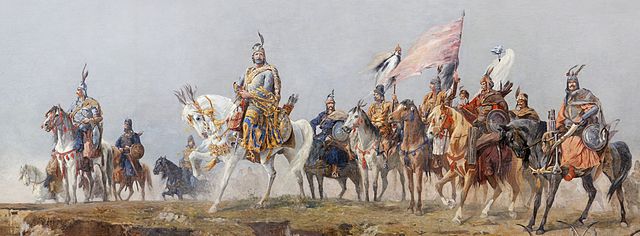
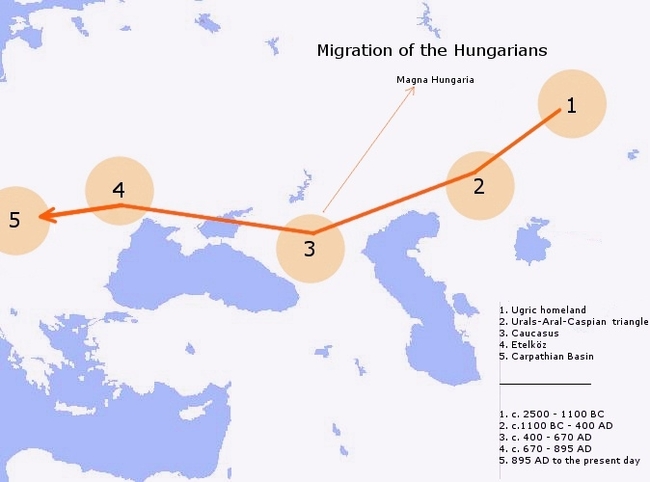
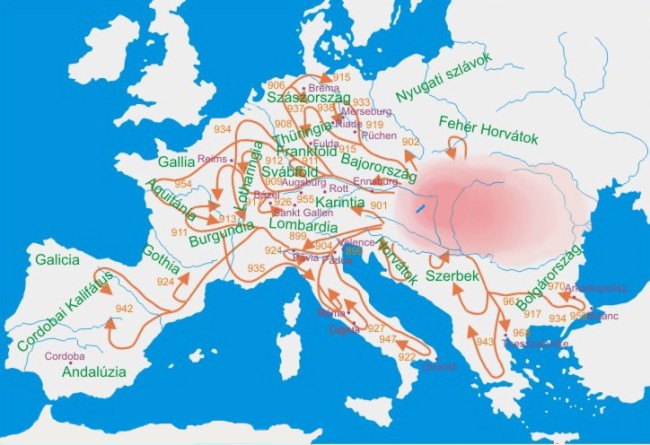
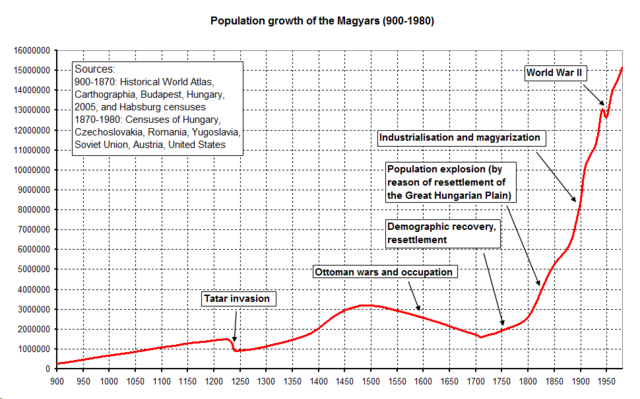
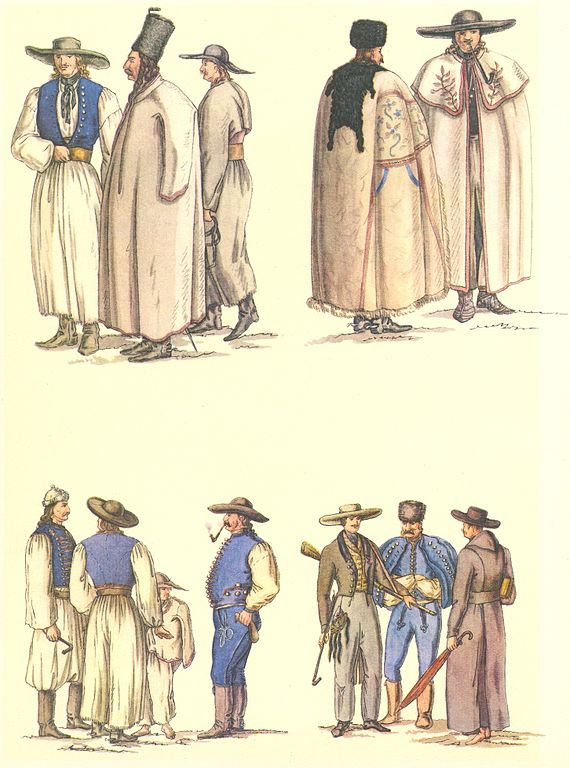
.png)
